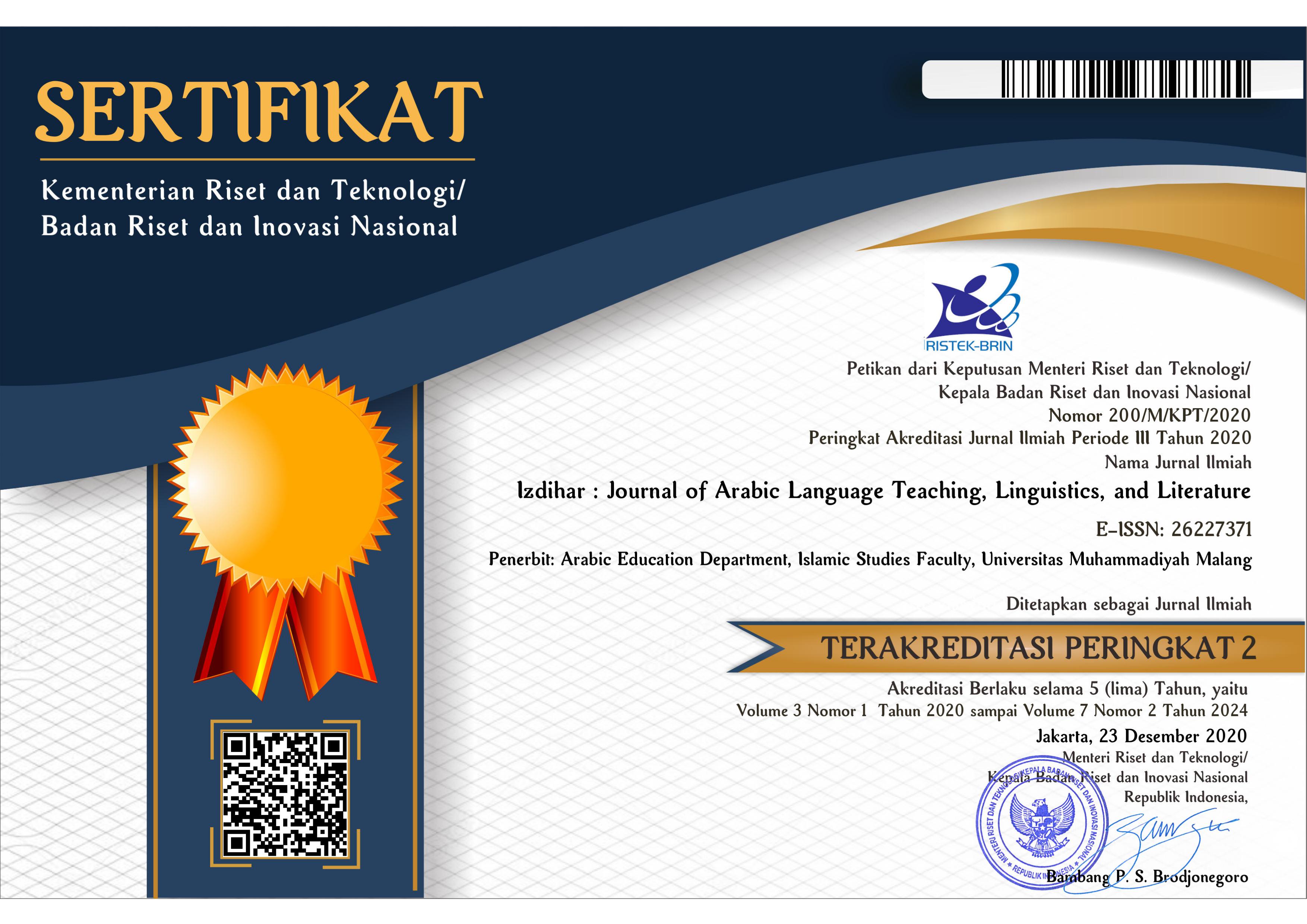Improving Arabic Speaking Skill through Mind Mapping Strategy
DOI:
https://doi.org/10.22219/jiz.v3i1.10967Keywords:
Boredom in Learning, Joyful Learning, Mind Mapping, Students’ AttitudeAbstract
Mind Mapping learning, that uses images and text with a purpose to describe the instructional ideas and concepts, gets lot attention by academicians. A renewal of Arabic learning method and strategy through mind mapping needs to be implemented in Arabic learning. The purpose of this study was to find out the implementation of Mind Mapping to improve students’ Arabic speaking skill. The research method used in this research was descriptive quantitative by emphasizing the improvement of students' speaking abilities and eliminating boredom in learning Arabic. The analysis process presented the results of scores carried out before and after the implementation of mind mapping in Arabic learning. The results of this study were Mind Mapping strategy was effective in learning Arabic, especially in learning speaking skills, because it gave students the courage to bring out new vocabulary they must master. The results were known from the difference between students’ attitude and effectiveness of mind mapping before using this instructional strategy. Based on the percentage results, the success rate of learning rose by 30% and the level of boredom of students in learning decreased by 35%. It means that this strategy can be implemented to improve Arabic speaking skill of students with joyful learning.
Downloads
References
Aziz, M. (2019). Understanding English Speaking Difficulties: Implications for the English Language Curriculum for the Arab Students in a Pakistani University. In English Language Teaching Research in the Middle East and North Africa (pp. 351–382). Springer.
Azizah, S. (2013). Efektivitas Penggunaan Strategi Mind Mapping Mata Kuliah Writing. NUANSA: Jurnal Penelitian Ilmu Sosial Dan Keagamaan Islam, 10(2), 51-63. DOI: https://dx.doi.org/10.19105/nuansa.v10i2.175
Azizah, S. N. (2015). Peningkatan Konsentrasi dan Hasil Belajar IPA Melalui Mind Mapping Siswa Kelas V SDN Jomblangan. BASIC EDUCATION, 4(5), 1-3. DOI: https://doi.org/10.23917/indigenous.v12i1.1558
Buran, A., & Filyukov, A. (2015). Mind mapping technique in language learning. Procedia-Social and Behavioral Sciences, 206, 215–218. DOI: https://doi.org/10.1016/j.sbspro.2015.10.010
Buzan, T. (2009). Buku pintar mind mapping. Jakarta: PT. Gramedia Pustaka Utama.
Chung, W.-L., Jarmulowicz, L., & Bidelman, G. M. (2017). Auditory processing, linguistic prosody awareness, and word reading in Mandarin-speaking children learning English. Reading and Writing, 30(7), 1407–1429. DOI: https://doi.org/10.1007/s11145-017-9730-8
Edward, C. (2009). Mind Mapping untuk anak sehat dan cerdas. Yogyakarta: Sakti.
Fatmawati, B. (2014). Identifikasi Berpikir Kreatif Mahasiswa Melalui Metode Mind Mapping. Bioedukasi: Jurnal Pendidikan Biologi, 7(2), 1–4. DOI: https://doi.org/10.20961/bioedukasi-uns.v7i2.2924
Fauzi, M. F. (2019). Tathwiir Al-Ghoz Ar-aqmii limaddati Tahbiiq Ash-sharf 1 ‘ala Haatif Mahmul Katadriibaat Al-idhofiyyah Khorij Al-Fash Ad-Diroosi. Buletin Al-Turas, 25(1), 129–139. DOI: https://doi.org/10.15408/bat.v25i1.11506
Fauzi, M. F., Buhun, M. F., & Purwadi, A. (2019). The Influence of Teams Games Tournament (TGT) toward Students’ Interest in Arabic Language Learning. Izdihar: Journal of Arabic Language Teaching, Linguistics, and Literature, 2(2), 135–148. DOI: https://doi.org/10.22219/jiz.v2i2.9986
Fujiawati, F. S. (2016). Pemahaman Konsep Kurikulum Dan Pembelajaran Dengan Peta Konsep Bagi Mahasiswa Pendidikan Seni. JPKS (Jurnal Pendidikan Dan Kajian Seni), 1(1),16-28. DOI: https://dx.doi.org/10.30870/jpks.v1i1.849
Fun, C. S., & Maskat, N. (2010). Teacher-centered mind mapping vs student-centered mind mapping in the teaching of accounting at pre-U Level–An action research. Procedia-Social and Behavioral Sciences, 7, 240–246. DOI: https://doi.org/10.1016/j.sbspro.2010.10.034
Ji, M., & Baek, S. (2019). Native Korean-Speaking Children Learning to Read in English: A Structural Analysis of L2-English Literacy Acquisition. Journal of Psycholinguistic Research, 48(2), 391–415. DOI: https://doi.org/10.1007/s10936-018-9610-7
Keeton, N., Kathard, H., & Singh, S. (2017). Clinical educators’ experiences of facilitating learning when speaking a different language from both the student and client. BMC Research Notes, 10(1), 546-553. DOI: https://doi.org/10.1186/s13104-017-2874-4
Laungeng, S. H. (2016). Strategi Peta Konsep Dan Strategi Tradisional Terhadap Pencapaian Komsas Dalam Bahasa Melayu Pelajar Tingkatan 4 (Concept Map Strategy and Traditional Strategy Form 4 Students Achievement in Literature Component in Malay Language). Jurnal Pendidikan Bahasa Melayu, 6(1), 30–37. http://spaj.ukm.my/jpbm/index.php/jpbm/article/view/106
Lubis, M. S., Syahrul, R., & Juita, N. (2014). Pengembangan Modul Pembelajaran Bahasa Indonesia Berbantuan Peta Pikiran Pada Materi Menulis Makalah Siswa Kelas XI SMA/MA. Bahasa, Sastra, Dan Pembelajaran, 2(1), 16-28. http://ejournal.unp.ac.id/index.php/bsp/article/view/5026
Musgamy, A. (2018). Quantum Learning Sebagai Proses Pembelajaran Bahasa Arab Aktif, Inovatif, Kreatif, Efektif Dan Menyenangkan. Al Daulah: Jurnal Hukum Pidana Dan Ketatanegaraan, 6(1), 145–155. DOI: https://doi.org/10.24252/ad.v6i1.4871
Nauli, H. (2013). Pengaruh Metode Mind Mapping terhadap Hasil Belajar Siswa Materi Lingkaran di SMP. Jurnal Pendidikan Dan Pembelajaran Khatulistiwa, 2(9), 1-12. http://jurnal.untan.ac.id/index.php/jpdpb/article/view/3215
Nur, C. (2019). Efektivitas Penggunaan Media Film Kartun terhadap Peningkatan Maharah Al-Kalam Peserta Didik. Diwan: Jurnal Bahasa Dan Sastra Arab, 5(1), 92–105. DOI:https://doi.org/10.24252/diwan.v5i1.6801
Nur, H. (2017). Penerapan Metode Muhadatsah dalam Meningkatkan Hasil Belajar Maharah Kalam Peserta Didik. Lentera Pendidikan: Jurnal Ilmu Tarbiyah Dan Keguruan, 20(2), 177–187. DOI:https://doi.org/10.24252/lp.2017v20n2i4
Nurlaila, A. R. (2018). Penggunaan Media Ular Tangga Untuk Meningkatkan Kemahiran Berbicara Bahasa Arab Siswa Pondok Pesantren Darul Hikmah Soncolela Kota Bima. AL-AF’IDAH: Jurnal Pendidikan Bahasa Arab Dan Pengajarannya, 2(1), 52–68. http://ejournal.iaimbima.ac.id/index.php/afidah/article/view/164
Nuryana, A., & Purwanto, S. (2010). Efektivitas brain gym dalam meningkatkan konsentrasi belajar pada anak. Indigenous: Jurnal Ilmiah Psikologi, 12(1), 88-98. DOI: https://doi.org/10.23917/indigenous.v12i1.1558
Pietrzykowska, A. (2014). The relationship between learning strategies and speaking performance. In Classroom-oriented Research (pp. 55–68). Springer.
Rahmaini, R. (2015). Strategi Pembelajaran Maharah Kalam Bagi Non Arab. Ihya Al-Arabiyah: Jurnal Pendidikan Bahasa Dan Sastra Arab, 1(2), 227-233. http://jurnal.uinsu.ac.id/index.php/ihya/article/view/1529/0
Roziqi, M. A. (2020). Development of Pictorial Textbook for Arabic Speaking Skill in Islamic Studies Program. Izdihar: Journal of Arabic Language Teaching, Linguistics, and Literature, 2(3), 217–230. DOI: https://doi.org/10.22219/jiz.v2i3.10161
Russak, S., & Fragman, A. (2014). Spelling development in Arabic as a foreign language among native Hebrew speaking pupils. Reading and Writing, 27(2), 359–381. DOI: https://doi.org/10.1007/s11145-013-9448-1
Sun, P. P., Zhang, L. J., & Gray, S. M. (2016). Development and Validation of the Speaking Strategy Inventory for Learners of Chinese (SSILC) as a Second/Foreign Language. The Asia-Pacific Education Researcher, 25(4), 593–604. DOI: https://doi.org/10.1007/s40299-016-0287-0
Syamaun, N. (2016). Pembelajaran Maharah al-Kalam untuk Meningkatan Keterampilan Berbicara Mahasiswa Program Studi Pendidikan Bahasa Arab Fakultas Tarbiyah dan Keguruan UIN Ar-Raniry Banda Aceh. Jurnal.Ar-Raniry.Ac.Id, 343–359. DOI: https://dx.doi.org/10.22373/l.v4i2.852
Teh, K. S. M., & Embi, M. A. (2009). Korelasi Strategi dengan Motivasi dalam Pembelajaran Bahasa Arab. Jurnal Pendidik Dan Pendidikan, 24, 109–123. https://core.ac.uk/reader/83543418
Zarkasyi, A. H. (2014). Waqi’ At-Ta’liim Al-Lughoh Al-Arabiyyah fi al-Ma’aahid wa Almadaaris bi Indunisiyyah. LISANUDHAD, 1(2). 11-24. DOI: http://dx.doi.org/10.21111/lisanudhad.v1i2.451
Downloads
Published
How to Cite
Issue
Section
License
Copyright Notice
Authors who publish with this journal agree to the following terms:
- Authors retain copyright and grant the journal right of first publication with the work simultaneously licensed under a Creative Commons Attribution-ShareAlike 4.0 International License that allows others to share the work with an acknowledgment of the work's authorship and initial publication in this journal.
- Authors are able to enter into separate, additional contractual arrangements for the non-exclusive distribution of the journal's published version of the work (e.g., post it to an institutional repository or publish it in a book), with an acknowledgment of its initial publication in this journal.
- Authors are permitted and encouraged to post their work online (e.g., in institutional repositories or on their website) prior to and during the submission process, as it can lead to productive exchanges, as well as earlier and greater citation of published work (See The Effect of Open Access).
Copyright (c) 2019 Izdihar : Journal of Arabic Language Teaching, Linguistics, and Literature

This work is licensed under a Creative Commons Attribution-ShareAlike 4.0 International License.

















